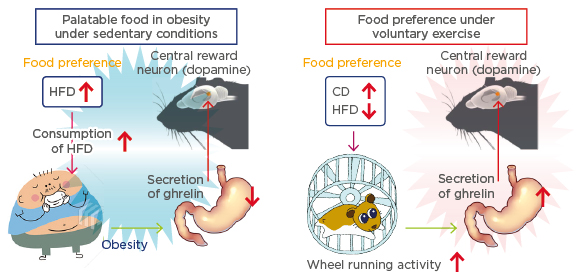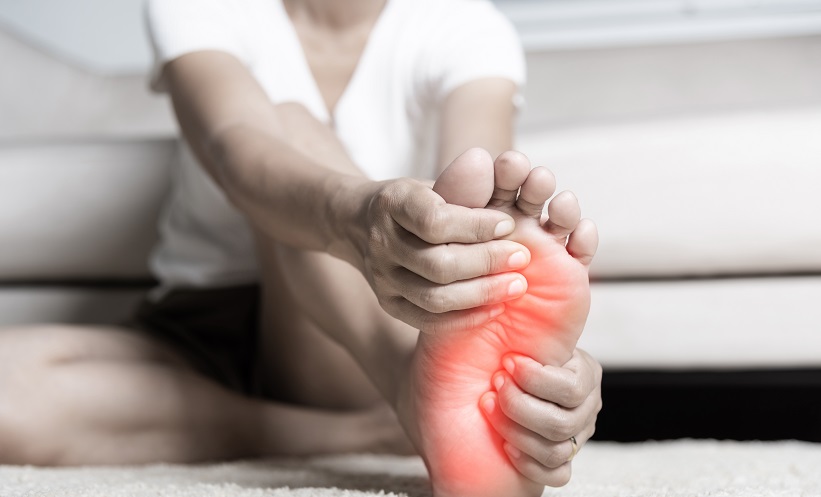BACKGROUND
In obese human subjects, hedonic eating is often present due to palatable foods perhaps promoting addiction in a similar way to drugs.1 It has been reported that voluntary exercise, such as wheel running, reduces the preference to palatable food such as that comprising a high-fat diet (HFD), although the mechanisms behind this are unclear.2 We previously reported that voluntary exercise contributed to an amelioration of abnormal feeding behaviour, with a concomitant restoration of ghrelin production in a HFD-induced obese model.3 It is known that hedonic eating is related to the activation of the central reward circuit via the ghrelin receptor in the ventral tegmental area (VTA) of the brain;4 therefore, we investigated whether voluntary exercise could modify food preference in relation to peripheral ghrelin and central dopamine systems in rats.
METHODS
Four-week-old, male Sprague-Dawley rats were housed as either a sedentary group (Se) (in ordinary cages throughout the experiment) or an exercise group (Ex) (in ordinary cages from Monday to Thursday and in special acrylic chambers equipped with a running wheel from Friday to Sunday). All rats were allowed free access to either the control, chow diet (CD; 10 kcal fat percentage) or HFD (60 kcal fat percentage); the choice of consumption was therefore their own preference. Food preference was measured each Monday morning until the rats reached 10 weeks old. After 10 weeks, dopaminergic activity within the nucleus accumbens in either Ex or Se was measured using microdialysis. Dopamine (DA) measurements were performed together with food consumption for 20 minutes after 24 hours of food deprivation. Furthermore, synthesised rat ghrelin (3 nmol/2 mL) was administered intravenously to Se at 10 weeks old, with microdialysis procedures performed thereafter.
RESULTS
Body weight and visceral fat volume in the Se group was significantly higher than those in the Ex group at 10 weeks old. In Se, most of the consumed food was HFD throughout the experiment. In contrast, the preference for HFD was attenuated by the induction of voluntary exercise, and around 40% of food consumption was substituted for CD after 5 weeks old to the end of the experimental period. In Se, DA level in the nucleus accumbens was increased in response to either CD or HFD fed for 20 minutes by 50% of basal levels. Voluntary exercise abolished the HFD-induced DA surge in spite of having no effect on CD-induced DA. Systemic ghrelin administration to Se abolished HFD-induced DA surge with no effect on CD-induced DA in the same manner as voluntary exercise did.
CONCLUSION
It was reported that systemic ghrelin administration brought about the inhibition of a DA surge associated with HFD through the activation of the dynorphin A/kappa opioid receptor pathway of DA neurons in VTA.5 As in our previous report,3 ghrelin secretion is enhanced by voluntary exercise and then suppresses DA response to HFD selectively in the VTA. Thus, it is fair to assume that voluntary exercise could attenuate the preference for palatable HFD, through the modulation of the central DA system together with peripheral ghrelin signals (Figure 1). Exercise is thus an essential strategy for the treatment of obesity from the aspect of the central reward circuit.

Figure 1 Putative mechanisms for the modification of food preference by voluntary exercise in relation to the central reward circuit and peripheral ghrelin signals.
Ghrelin secretion is increased in response to voluntary exercise, and subsequently suppresses dopamine release due to HFD consumption. Voluntary exercise, therefore, may reduce the palatability for HFD.
CD chow diet; HDF high fat diet.







